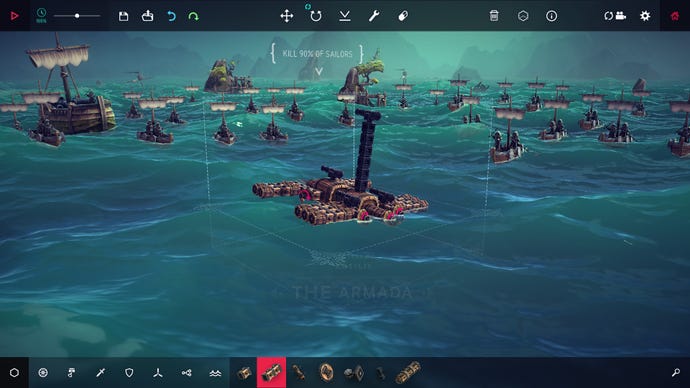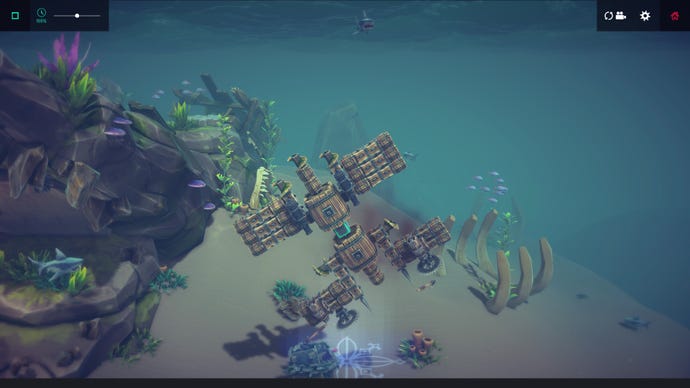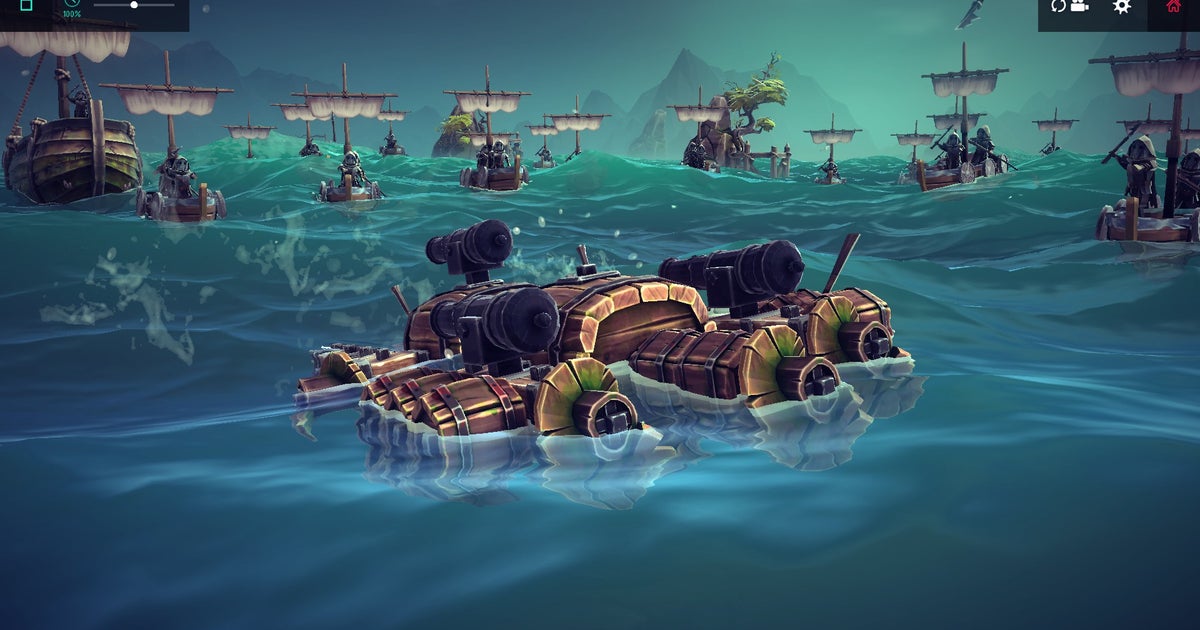I can’t compare my experience of writing a review for The Splintered Sea, the first paid expansion for the sneaky physics puzzler Besiege, to that of a sailor writing a diary facing deadly storms on the horizon. Still, if we take for granted the idea that the review is only really valuable as an insight into the player’s experience: I didn’t feel particularly good this week. Consider this: Splintered Sea is more Besiege thoughtfully applied to his already extensive toolkit. More importantly, it’s currently bringing me deep and deeply needed moments of untainted, childlike, vaguely orcish joy.
Besiege is basically a siege engine building game, but this expands to things like flying machines, nimble vehicles, and whatever else your imagination can conjure up. There’s no power limit or monetary value for the parts, so your only real limitations are whether your contraption can fit within the confines of the starting cube and whether it actually works. Fastening ten cannons to the sails may seem like a great idea, but they will soon bend and give way if not properly secured. You’ll also want to make sure the weight is balanced evenly across your contraption, at least if you want to be able to move around.
To lend some structure to its sandbox modes, the meat of Besiege consists of challenge maps. At first it might be something like “destroy 80% of everything on the screen” – everything on the screen is a mix of knights and structures. Later on, maybe the knights shoot fire arrows, or maybe the structures are fortified to the point where you’ll need a heavy weapon to deal with them. Splintered Sea adds 10 new challenge maps and 8 new water building blocks. Of these, things like adjustable buoyancy barrels and rotating water propellers are the most important, as they dictate things like immersion and handling.
Along with that, it also features a lot of water that can also be used in its sandbox level editor. Adding water might not sound like much, but it brings with it all the physics simulations necessary to make building vessels for navigating water – both on the surface and in the deep – feel complex and rewarding. I felt like a complete genius the first time I set up two spinning things to allow me to steer horizontally, only to find out that I would also need to effectively build a working submarine for the later levels. I can’t talk about it too much because I stopped paying attention in science class pretty young, but I will say this water has moxy!
My high level takeaway from playing some of the base game and most of its expansion levels is this: I can’t believe I waited this long to play Besiege, although I do blame the marketing somewhat. Long story short: no one told me this game was actually an Ork simulator. Here’s the damn contraption I knew simply as “spikeyboy1” since that’s what I saved him as:
The key difference between the facilities in Besiege and those created by Warhammer’s Orks is that the ones here don’t just run on faith – you’ll have to make sure everything is in working order. I would later make countless improvements to his spikyship, notably a series of clamps to prevent it from falling apart during a particularly vigorous rampage. Sometimes the game will give you a mission that requires not mindless destruction but deliberate movement, in which case I’d be forced to replace some of the undead decorations with more practical gadgets like grapples or vacuum guns. Sometimes you need to destroy something quite tall, in which case my preferred approach was to make a column of extendable extendo-pistons with a cannon on top. You usually get at least one good shot in before you completely roll over.

Regarding the visuals here, I was tempted to write something along the lines of “they shouldn’t have made it look that good!”. That’s probably not true, as I understand how important it is to get attention when someone scrolls through Steam. Still, Besiege is a real looker at the top of its wonderful juxtapositions of sophistication and silliness, practicality and chivalrous grind. Ambient music and heavy rain tell of a conflict bringing despair to the land. I see a mission called The Duke’s Plea, reminiscent of a desperate call to end this senseless bloodshed. I charge and it’s just me and my ridiculous death machine and a bunch of knights, one of whom picks up a parchment in my wake. Was that your plan, Lord Duke? Sheet! Well, that won’t stop me because I’ve only learned to read blueprints for war crime accessories
Splintered Sea itself is even more beautiful, the gray boxes of the base game replaced with full ocean scenes that stretch out in every direction. There are fish in the ocean and you can kill them individually. I didn’t do that, of course. They just happened to get my bits. Here I am with a harpoon to steal some treasure. The fish just got in the way:

I will say that any given set of levels in Besiege, and especially the 10 levels in Splintered Sea, can usually be knocked out pretty quickly once you learn the basics. So if you’re considering getting them, it’s worth asking yourself where you fall on the indoor/outdoor scale. Basically, will you enjoy building and experimenting for their own sake, or might you lose interest once you overcome all the challenges? If it’s the latter, you could be in for some lively evenings, so something to keep in mind.
You’ve probably figured out by now that there’s no real storytelling in Besiege, which is good since the game doesn’t try to do that. Still, aside from the little snippets of scene setting achieved by the challenge layouts, I found that Besiege told me a story: It was a story about how some things are so ingrained that it’s very hard for the world to knock them out of us. One of those things is playing with toys, and another is taking them apart to see how they work, then building them up again.
I’m not sure I have a grand theory about how games should be written, but I think we should spend less time trying to convince doubters that “games are more than toys” and more time celebrating the fact that that toys can be great and incredibly complex and precious things. Besiege is a fantastic toy – which is to say it’s a great and incredibly complex and useful thing – and Splintered Sea is more than that, but with boats and sharks. Also a giant squid at one point. It’s great and I love it. Seven out of six, five overall trembling wood.
This review is based on a game review compilation provided by the developer.



